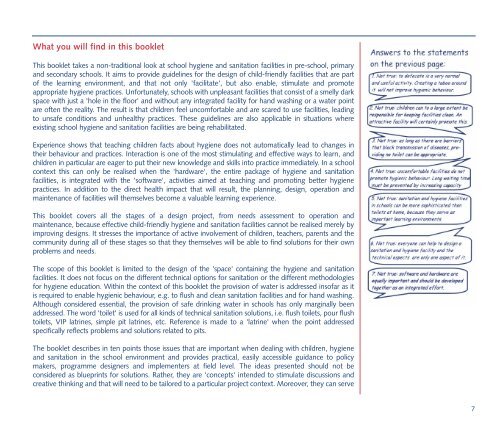Child-Friendly Hygiene and Sanitation Facilities in Schools
Child-Friendly Hygiene and Sanitation Facilities in Schools
Child-Friendly Hygiene and Sanitation Facilities in Schools
You also want an ePaper? Increase the reach of your titles
YUMPU automatically turns print PDFs into web optimized ePapers that Google loves.
What you will f<strong>in</strong>d <strong>in</strong> this booklet<br />
This booklet takes a non-traditional look at school hygiene <strong>and</strong> sanitation facilities <strong>in</strong> pre-school, primary<br />
<strong>and</strong> secondary schools. It aims to provide guidel<strong>in</strong>es for the design of child-friendly facilities that are part<br />
of the learn<strong>in</strong>g environment, <strong>and</strong> that not only 'facilitate', but also enable, stimulate <strong>and</strong> promote<br />
appropriate hygiene practices. Unfortunately, schools with unpleasant facilities that consist of a smelly dark<br />
space with just a 'hole <strong>in</strong> the floor' <strong>and</strong> without any <strong>in</strong>tegrated facility for h<strong>and</strong> wash<strong>in</strong>g or a water po<strong>in</strong>t<br />
are often the reality. The result is that children feel uncomfortable <strong>and</strong> are scared to use facilities, lead<strong>in</strong>g<br />
to unsafe conditions <strong>and</strong> unhealthy practices. These guidel<strong>in</strong>es are also applicable <strong>in</strong> situations where<br />
exist<strong>in</strong>g school hygiene <strong>and</strong> sanitation facilities are be<strong>in</strong>g rehabilitated.<br />
Experience shows that teach<strong>in</strong>g children facts about hygiene does not automatically lead to changes <strong>in</strong><br />
their behaviour <strong>and</strong> practices. Interaction is one of the most stimulat<strong>in</strong>g <strong>and</strong> effective ways to learn, <strong>and</strong><br />
children <strong>in</strong> particular are eager to put their new knowledge <strong>and</strong> skills <strong>in</strong>to practice immediately. In a school<br />
context this can only be realised when the 'hardware', the entire package of hygiene <strong>and</strong> sanitation<br />
facilities, is <strong>in</strong>tegrated with the 'software', activities aimed at teach<strong>in</strong>g <strong>and</strong> promot<strong>in</strong>g better hygiene<br />
practices. In addition to the direct health impact that will result, the plann<strong>in</strong>g, design, operation <strong>and</strong><br />
ma<strong>in</strong>tenance of facilities will themselves become a valuable learn<strong>in</strong>g experience.<br />
This booklet covers all the stages of a design project, from needs assessment to operation <strong>and</strong><br />
ma<strong>in</strong>tenance, because effective child-friendly hygiene <strong>and</strong> sanitation facilities cannot be realised merely by<br />
improv<strong>in</strong>g designs. It stresses the importance of active <strong>in</strong>volvement of children, teachers, parents <strong>and</strong> the<br />
community dur<strong>in</strong>g all of these stages so that they themselves will be able to f<strong>in</strong>d solutions for their own<br />
problems <strong>and</strong> needs.<br />
The scope of this booklet is limited to the design of the 'space' conta<strong>in</strong><strong>in</strong>g the hygiene <strong>and</strong> sanitation<br />
facilities. It does not focus on the different technical options for sanitation or the different methodologies<br />
for hygiene education. With<strong>in</strong> the context of this booklet the provision of water is addressed <strong>in</strong>sofar as it<br />
is required to enable hygienic behaviour, e.g. to flush <strong>and</strong> clean sanitation facilities <strong>and</strong> for h<strong>and</strong> wash<strong>in</strong>g.<br />
Although considered essential, the provision of safe dr<strong>in</strong>k<strong>in</strong>g water <strong>in</strong> schools has only marg<strong>in</strong>ally been<br />
addressed. The word 'toilet' is used for all k<strong>in</strong>ds of technical sanitation solutions, i.e. flush toilets, pour flush<br />
toilets, VIP latr<strong>in</strong>es, simple pit latr<strong>in</strong>es, etc. Reference is made to a 'latr<strong>in</strong>e' when the po<strong>in</strong>t addressed<br />
specifically reflects problems <strong>and</strong> solutions related to pits.<br />
The booklet describes <strong>in</strong> ten po<strong>in</strong>ts those issues that are important when deal<strong>in</strong>g with children, hygiene<br />
<strong>and</strong> sanitation <strong>in</strong> the school environment <strong>and</strong> provides practical, easily accessible guidance to policy<br />
makers, programme designers <strong>and</strong> implementers at field level. The ideas presented should not be<br />
considered as bluepr<strong>in</strong>ts for solutions. Rather, they are 'concepts' <strong>in</strong>tended to stimulate discussions <strong>and</strong><br />
creative th<strong>in</strong>k<strong>in</strong>g <strong>and</strong> that will need to be tailored to a particular project context. Moreover, they can serve<br />
7

















